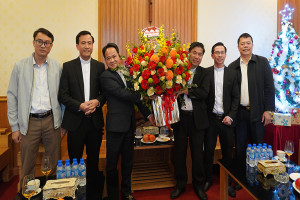
Tien Giang province: The provincial Committee for Religious Affairs inspects state administration on religion in the districts of Cai Lay and Tan Phuoc
08/25/2014
To implement the inspection and examination plan 2014 in order to enhance the effectiveness of state’s administration on religious affairs and recommend measures to overcome shortcomings in state’s administration on religion in the province, on August 12th, 2014, the provincial Committee for Religious Affairs under Department of Home Affairs had working sessions at the Office of Home Affairs in the districts Cai Lay and Tan Phuoc.
Cai Lay district has 16 commune -level administrative units, with an area 29,599.95 ha, population of 186,583 people, 23,220 religious followers and 112 worshipping places belonging to Buddhism, Catholicism, Protestantism (2 churches and 7 meeting groups), Caodaism, Hòa Hỏa Buddhism (4 Executive Boards) and Minh Su sect.
Tan Phuoc district has 13 commune -level administrative units, with an area 32,991.44 ha, population of 42,031 people, 3,231 religious followers and 11 worshipping places belonging to Catholicism, Buddhism, Protestantism (2 meeting groups), Caodaism and Hòa Hỏa Buddhism.
Inspecting results from the 2 districts showed that religious needs of people have been addressed timely and properly. The District Party Committee and People’s Committee have been promptly advised by religious officials to solve religious issues in accordance with law. Dissemination of the laws on religion has been conducted for both local and agencies, departments, religious organizations and followers.
The two districts have also set out the tasks and measures to well conduct the state’s administration on religious activities in the coming time, such as dissemination of policies and guidelines on religion; enhancing administrative reform; regularly monitoring the religious situation in order to promptly address the legitimate aspirations of religious organizations and followers; mobilizing religions participate in building new rural movements in the localities.
Trần Văn Khuê




